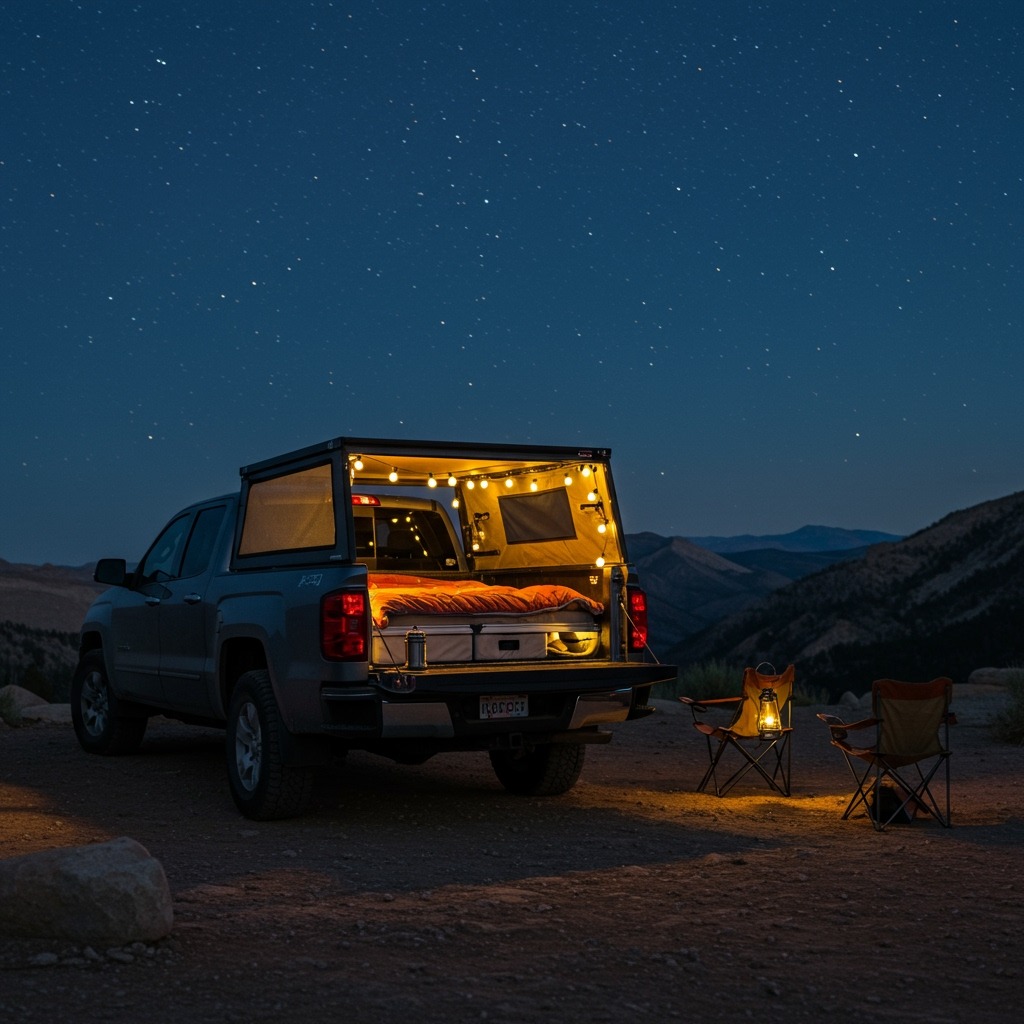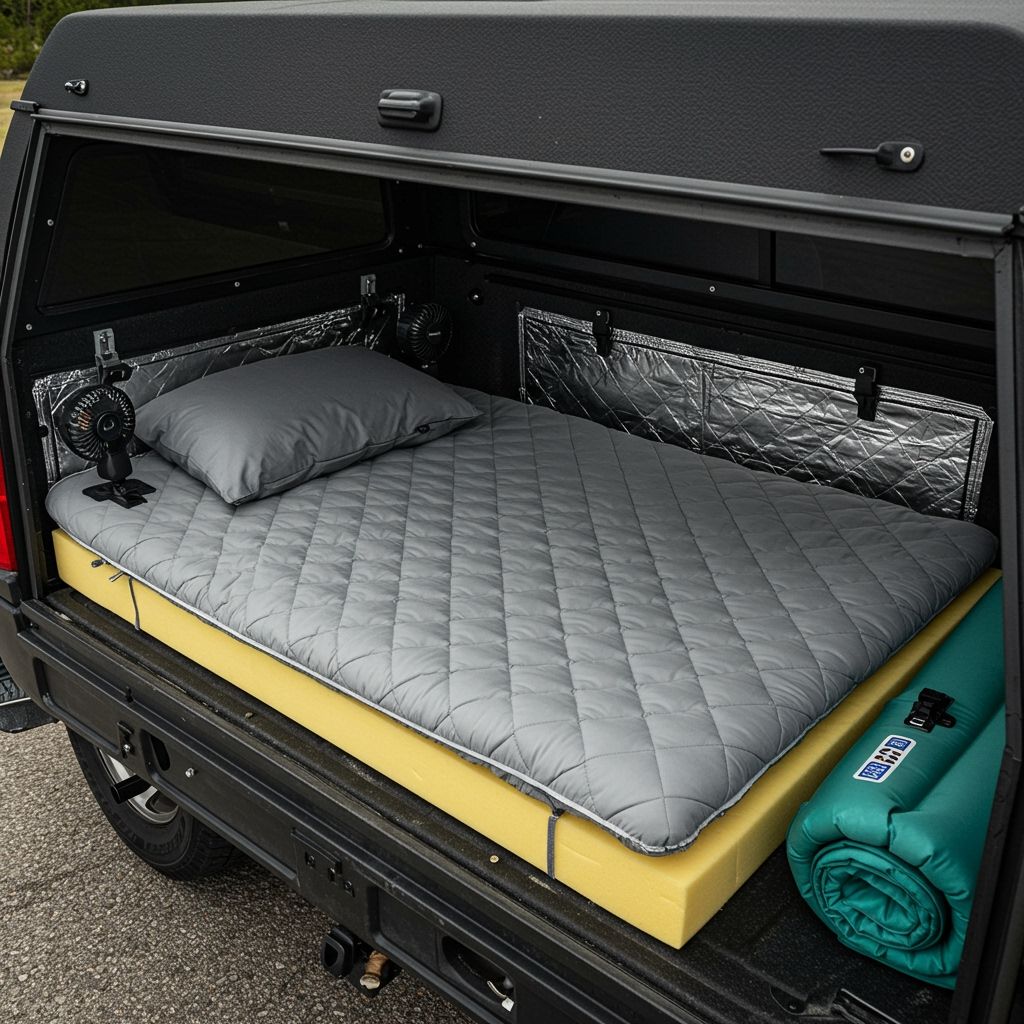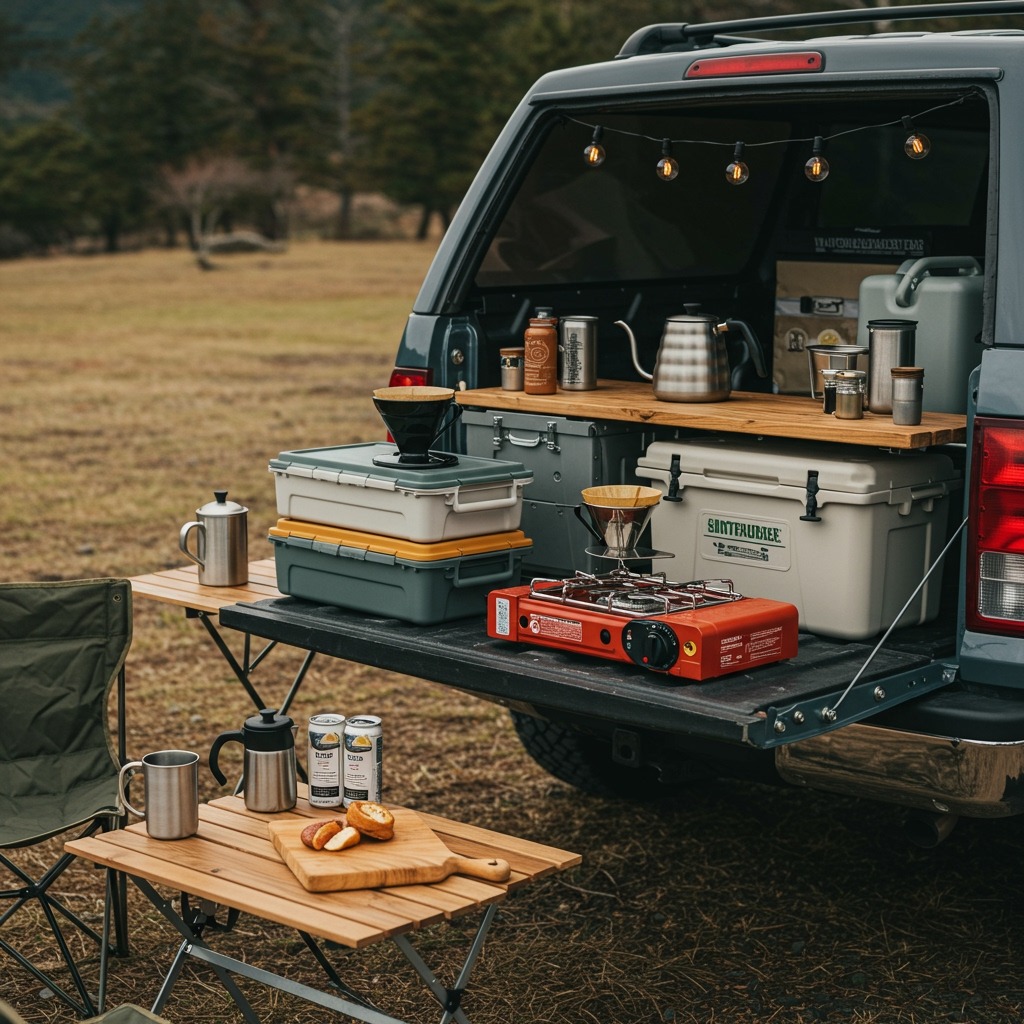Imagine this: You’ve just finished a long drive, the stars are beginning to pop, and instead of wrestling with tent poles, you simply climb into the comfortable haven of your truck bed. Sound appealing? That’s the magic of a truck bed camping setup. It’s about unlocking a new level of freedom and accessibility for your outdoor adventures, whether you prefer primitive camping deep in the wilderness or a more established spot.
For many, traditional tent camping means pitching on uneven ground, dealing with unexpected rain, and packing up a soggy mess. RVs offer comfort but limit where you can go. Truck bed camping, however, provides a perfect middle ground: the comfort and security of a solid roof over your head, combined with the go-anywhere capability of your truck. If you’re new to the outdoor world, getting started with camping for beginners can feel daunting, but a truck bed setup simplifies much of the process. Whether you’re heading to a remote fishing spot, hitting a national park, or just escaping for a weekend, a well-planned truck bed camping setup can transform your experience.
Ready to ditch the hassle and embrace effortless adventure? This comprehensive guide will walk you through everything you need to know to create your ideal truck bed camping setup, from choosing the right shelter to smart storage solutions and essential gear.

Understanding Your Truck: The Foundation of Your Camp
Your truck is more than just a vehicle; it’s the foundation of your mobile campsite. Understanding its specifics is the first step in building the perfect truck bed camping setup.
- Truck Bed Size Matters: Is your truck a short bed or a long bed? This dictates the internal space you’ll have for sleeping and gear. Short beds (around 5-6 feet) are common in crew cab trucks and work well for solo campers or couples who don’t mind a snug fit. Long beds (around 8 feet) offer ample space, allowing for more elaborate setups, dedicated storage, or even room for a furry friend. Knowing your bed’s dimensions is critical for selecting compatible shelters and mattresses.
- Truck Bed Type: Your existing truck bed setup significantly impacts your camping options.
- Open Bed: The simplest and most budget-friendly starting point. You can throw in an air mattress and a sleeping bag, but you’ll be exposed to the elements. This is great for clear nights or if you plan on adding a truck tent.
- Truck Cap/Topper (Shell): These hard shells enclose your truck bed, providing instant weather protection and security. They range from basic fiberglass models to high-end options with windows, racks, and even interior finishes. A cap turns your truck bed into a secure, semi-permanent shelter, ideal for stealth camping or extended trips.
- Slide-in Campers: These are essentially miniature RVs designed to slide directly into your truck bed. They come fully equipped with kitchens, bathrooms, and sleeping areas, offering the most comforts. They are, however, the most expensive and heaviest option, often requiring a heavy-duty truck.
- Bed Liners and Protection: A spray-in or drop-in bed liner is crucial. It protects your truck bed from scratches and dents, provides a non-slip surface for your gear, and adds a layer of insulation and comfort under your sleeping area. Consider adding a rubber mat on top of your liner for extra cushioning and sound dampening.
Essential Truck Bed Camping Shelter Options
Choosing the right shelter is the cornerstone of your truck bed camping setup. Each option offers unique benefits, depending on your budget, comfort needs, and how often you plan to camp.
Truck Bed Tents
These tents are specifically designed to fit over your truck bed, creating a contained shelter.
- Pros:
- Affordable: Generally the least expensive dedicated shelter option.
- Easy to Store: They pack down small when not in use, freeing up your truck bed for other purposes.
- Weather Protection: Offers good protection from rain, wind, and bugs, unlike an open bed.
- Cons:
- Setup Time: While faster than a ground tent, they still require assembly.
- Less Stealthy: Clearly identifies you as a camper, which might be a consideration for urban or roadside camping.
- Key Considerations: Look for models with a good rainfly, ample ventilation (windows and vents), and sturdy pole construction. Ensure it matches your truck bed size.
Truck Caps/Toppers (Shells)
These hard shells are a popular choice for those who want a more permanent and secure setup.
- Pros:
- Permanent & Secure: Once installed, they offer robust protection and a lockable space.
- Excellent Weather Protection: Impervious to rain and strong winds, providing a solid shelter.
- Stealth: From the outside, your truck still looks like a regular truck, ideal for low-profile camping.
- Cons:
- Cost: Significantly more expensive than truck bed tents.
- Weight & Reduced Utility: Adds weight to your truck and can make hauling tall items difficult when not camping.
- Customization Options: Many caps offer options like side access windows, roof racks for extra gear like kayaks or bikes, and even interior carpeting or insulation.
Slide-in Campers
The ultimate in truck bed camping luxury, these are full-fledged recreational vehicles that sit in your truck bed.
- Pros:
- Most Features: Often include a small kitchen, bathroom, dinette, and dedicated sleeping area.
- Self-Contained: Many are equipped with water tanks, propane, and batteries for off-grid living.
- Comfort: Offer a high level of comfort, similar to a small RV.
- Cons:
- High Cost: By far the most expensive truck camping option.
- Heavy: Requires a heavy-duty truck with appropriate payload capacity.
- Requires Specific Truck: Not all trucks can handle the weight and size of a slide-in camper.
DIY Builds
For the handy and budget-conscious, transforming your truck bed into a custom camper is a rewarding project.
- Pros:
- Customizable: You design it exactly how you want it, optimizing for your specific needs.
- Budget-Friendly: Can be significantly cheaper than buying pre-made solutions.
- Cons:
- Time Commitment: Requires significant time and effort.
- Skill Required: Basic carpentry and electrical knowledge are beneficial.
- Basic Ideas: A simple plywood platform creates a flat sleeping surface with storage underneath. You can add drawers, shelves, and even a small counter space. For inspiration, many online communities share detailed truck bed camping build logs and videos.
Creating a Comfortable Sleeping Area
A good night’s sleep is paramount to enjoying your camping trip. Your truck bed camping setup needs a comfortable and insulated sleeping zone.
- Mattress/Sleeping Pad:
- Air Mattresses: Offer excellent comfort and pack down relatively small. However, they are prone to punctures and require a pump.
- Foam Mattresses: More durable and provide better insulation. They can be bulky but offer consistent comfort. Consider a custom-cut foam mattress to perfectly fit your truck bed’s contours.
- Self-Inflating Pads: A good compromise, offering comfort and insulation with easier setup than traditional air mattresses.
- Bedding: Choose your bedding based on the expected temperatures. A good sleeping bag rated for the lowest temperatures you expect is essential. Add extra blankets for warmth or a light sheet for warmer nights. Don’t forget your pillows!
- Insulation & Ventilation: This is crucial for comfort in all seasons.
- Insulation: Reflectix, an insulating bubble wrap material, can be cut to fit your windows, providing excellent thermal regulation. Foam board insulation can be added to the ceiling and walls of a truck cap.
- Ventilation: Good airflow prevents condensation, which can make your sleeping area damp and cold. Add small battery-powered fans to circulate air, especially if your truck cap doesn’t have roof vents. Keeping windows cracked (with screens) is also vital. Learning how to stay cool while camping or stay warm while camping often comes down to managing airflow and insulation.

Power, Lighting, and Electronics
Staying charged and illuminated makes your truck bed camping setup feel much more like home.
- Power Solutions:
- Portable Power Stations: Devices like Jackery or Goal Zero are game-changers. They are rechargeable battery packs with AC outlets, DC ports, and USB chargers, perfect for powering small appliances, charging phones, and running lights.
- Dual Battery Setups: For more extensive power needs, consider installing a secondary battery in your truck, isolated from your starting battery. This ensures you won’t drain your main battery overnight.
- Solar Panels: Pair portable power stations or dual battery systems with flexible solar panels for off-grid recharging.
- Lighting:
- Interior LED Strips/Lanterns: Battery-operated LED strips can provide excellent ambient lighting. Portable LED lanterns are great for general illumination.
- Headlamps: Essential for hands-free lighting when cooking, reading, or navigating outside the truck at night.
- Charging: Ensure you have enough USB ports and perhaps a small inverter for charging laptops or camera batteries.
Kitchen and Food Storage
Eating well is part of the camping experience. A functional kitchen area enhances your truck bed camping setup.
- Coolers:
- High-Performance Rotomolded Coolers: Brands like Yeti or RTIC keep ice for days, essential for longer trips.
- Electric Coolers: These plug into a 12V outlet and act more like a mini-fridge, eliminating the need for ice.
- Cooking Gear: A portable propane stove (single or double burner) is a must. Pack lightweight cookware, basic utensils, and biodegradable soap for cleanup. You might even find yourself wanting to make cowboy coffee right from your truck bed.
- Water Storage: Carry enough potable water in dedicated jerry cans or collapsible water tanks. Consider a small water filter or purification tablets for emergencies.
- Food Organization: Use sturdy, stackable storage bins to keep your food organized and secure. Airtight containers protect food from pests and moisture. For ideas on easy camping meals, check out our guide on camping breakfast ideas.
Organization and Storage Solutions
A cluttered truck bed is a frustrating truck bed. Smart organization maximizes your space and keeps your truck bed camping setup tidy.
- Under-Platform Storage: If you build a sleeping platform, the space underneath is gold. Use it for flat items like folding chairs, tables, or fishing rods.
- Storage Bins/Drawers: Clear, stackable bins are your best friends. Label them for easy access. Custom-built drawers can provide more refined storage.
- Roof Racks: If you have a truck cap, a roof rack is invaluable for carrying bulky items that won’t fit inside, such as kayaks, mountain bikes, or extra gear cases.
- Nets and Bungee Cords: Use cargo nets to secure loose items against the walls of your truck bed or cap. Bungee cords are endlessly useful for strapping things down and preventing shifting during travel.
- Overhead Storage: Install simple cargo nets or small shelves along the ceiling of your truck cap for lightweight items like clothing or toiletries.
Essential Gear for a Complete Setup
Beyond the core components of your truck bed camping setup, these items enhance comfort, safety, and convenience.
- Camp Chairs and Table: Essential for relaxing outside your truck, cooking, and eating. Look for compact, foldable designs.
- First-Aid Kit: A well-stocked first-aid kit is non-negotiable for any outdoor adventure.
- Navigation Tools: Even with a phone, carry a physical map (and know how to read a topographic map) and a compass. A dedicated GPS device is also a good backup.
- Recovery Gear: If you plan on venturing off-road, ensure you have recovery straps, shackles, and a shovel.
- Trash Management: Pack out everything you pack in. Bring durable trash bags and a designated trash container.
- Lighting: Beyond interior lights, consider a bright, portable lantern for illuminating your campsite and a good headlamp for personal use.

Tips for a Successful Truck Bed Camping Experience
You’ve got your truck bed camping setup ready, now it’s time to hit the road! Here are some final tips to ensure a smooth and enjoyable trip.
- Test Your Setup: Before embarking on a long journey, do a trial run in your driveway or a local campground. This allows you to identify any issues, forgotten items, or discomforts before you’re deep in the wilderness.
- Choose the Right Campsite: Look for level ground to ensure a comfortable night’s sleep. Research campsite regulations regarding overnight parking, fires, and waste disposal.
- Weather Preparedness: Always check the forecast and pack accordingly. Even if you’re sleeping in a truck bed, unexpected cold snaps or rain can make a trip miserable if you’re not prepared with the right camping clothes or insulation.
- Leave No Trace Principles: This is vital. Pack out all trash, dispose of waste properly, respect wildlife, and minimize your impact on the environment. Leave the campsite cleaner than you found it.
- Security: Always lock your truck, especially if you’re leaving it unattended. Keep valuables out of sight. While truck bed camping offers more security than a tent, it’s still smart to be vigilant.
FAQ Section
Q: Can I stand up in my truck bed camping setup?
A: It depends on your truck bed type and height. If you have a tall truck cap or a pop-up camper, yes, you’ll likely have standing room. With a truck bed tent or an open bed, standing will be limited or impossible.
Q: How do I deal with condensation in my truck bed?
A: Ventilation is key. Ensure good airflow by cracking windows (with screens), using fans, or installing vents in your truck cap. Insulating walls and ceilings also helps reduce the temperature difference that causes condensation.
Q: Is truck bed camping safe?
A: Generally, yes. It offers more security and protection from wildlife and bad weather than ground tent camping. However, always be aware of your surroundings, secure your belongings, and choose safe, legal camping spots.
Q: What about bathroom facilities when truck bed camping?
A: This depends on your style of camping. If you’re in developed campgrounds, restrooms are available. For primitive or dispersed camping, you’ll need to pack a portable toilet, a privacy tent, or utilize “Leave No Trace” cat holes.
Q: How much does a good truck bed camping setup cost?
A: The cost varies wildly! A basic open-bed setup with an air mattress and sleeping bag can be under $200. A truck bed tent might be $200-$500. A quality truck cap can range from $1,500 to $4,000+. Slide-in campers can go from $5,000 to $30,000+. DIY builds can be very affordable, depending on your materials and ambition. It really comes down to your needs and budget.
Ready to embark on your next adventure? With a well-thought-out truck bed camping setup, you’ll enjoy the open road and the great outdoors like never before. Get out there and explore!
